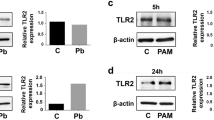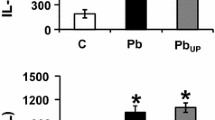Abstract
Fungi that belong to the genus Paracoccidioides are the etiologic agents of paracoccidioidomycosis, a human systemic mycosis, which occurs in Latin America. Epithelial cell is one of the first cells that interact with these fungi and responds by secreting inflammatory mediators such as cytokines. In the present study, we demonstrate that yeasts of different isolates of Paracoccidioides brasiliensis (Pb18 and Pb03) and Paracoccidioides lutzii (Pb01) distinctly promoted interleukin (IL)-8 secretion by the lung epithelial cell line A549. Depending on the isolate, this cytokine release may rely on the epithelial cell interaction with fungal secreted components or direct contact with the pathogen. In addition, adhesion of yeasts to the pulmonary epithelial cells was also different among Paracoccidioides isolates, and the highest percentage of A549 cells with adhered fungi was observed with P. lutzii. All Paracoccidioides isolates induced an expression increase of α3 and α5 integrins in A549 cells and, using small interfering RNA, we observed that the integrin silencing promoted a reduction of P. lutzii adhesion, which suggests the involvement of integrins in this event. Together, these results indicate that host epithelial cell response may depend on the isolate of Paracoccidioides.






Similar content being viewed by others
References
Bellissimo-Rodrigues F, Bollela VR, Da Fonseca BA, Martinez R (2013) Endemic paracoccidioidomycosis: relationship between clinical presentation and patients’ demographic features. Med Mycol 51:313–318
Shikanai-Yasuda MA, Mendes RP, Colombo AL, Telles FQ, Kono A, Paniago AMM, Nathan A, Valle ACFD, Bagagli E, Benard G, Ferreira MS, Teixeira MM, Vergara MLS, Pereira RM, Cavalcante RS, Hahn R, Durlacher RR, Khoury Z, Camargo ZP, Moretti ML, Martinez R (2018) Brazilian guidelines for the clinical management of paracoccidioidomycosis. Epidemiol Serv Saude 27:e0500001
Teixeira MM, Theodoro RC, de Carvalho MJ, Fernandes L, Paes HC, Hahn RC, Mendoza L, Bagagli E, San-Blas G, Felipe MS (2009) Phylogenetic analysis reveals a high level of speciation in the Paracoccidioides genus. Mol Phylogenet Evol 52:273–283
Muñoz JF, Farrer RA, Desjardins CA, Gallo JE, Sykes S, Sakthikumar S, Misas E, Whiston EA, Bagagli E, Soares CM, Teixeira MM, Taylor JW, Clay OK, McEwen JG, Cuomo CA (2016) Genome diversity, recombination, and virulence across the major lineages of Paracoccidioides. mSphere 1(5):e00213–e00216
Matute DR, McEwen JG, Puccia R, Montes BA, San-Blas G, Bagagli E, Rauscher JT, Restrepo A, Morais F, Niño-Vega G, Taylor JW (2006) Cryptic speciation and recombination in the fungus Paracoccidioides brasiliensis as revealed by gene genealogies. Mol Biol Evol 23:65–73
Suzuki T, Chow CW, Downey GP (2008) Role of innate immune cells and their products in lung immunopathology. Int J Biochem Cell Biol 40:1348–1361
Whitsett JA, Alenghat T (2015) Respiratory epithelial cells orchestrate pulmonary innate immunity. Nat Immunol 16:27–35
Alcantara C, Maza PK, Barros BC, Suzuki E (2015) Role of protein kinase C in cytokine secretion by lung epithelial cells during infection with Paracoccidioides brasiliensis. Pathog Dis 73:1–7
Maza PK, Oliveira P, Toledo MS, Paula DM, Takahashi HK, Straus AH, Suzuki E (2012) Paracoccidioides brasiliensis induces secretion of IL-6 and IL-8 by lung epithelial cells. Modulation of host cytokine levels by fungal proteases. Microbes Infect 14:1077–1085
Barros BC, Maza PK, Alcantara C, Suzuki E (2016) Paracoccidioides brasiliensis induces recruitment of α3 and α5 integrins into epithelial cell membrane rafts, leading to cytokine secretion. Microbes Infect 18:68–77
Oliveira P, Juliano MA, Tanaka AS, Carmona AK, Dos Santos SM, de Barros BC, Maza PK, Puccia R, Suzuki E (2017) Paracoccidioides brasiliensis induces cytokine secretion in epithelial cells in a protease-activated receptor-dependent (PAR) manner. Med Microbiol Immunol 206:149–156
Schaller M, Mailhammer R, Grassl G, Sander CA, Hube B, Korting HC (2002) Infection of human oral epithelia with Candida species induces cytokine expression correlated to the degree of virulence. J Invest Dermatol 118:652–657
Maza PK, Suzuki E (2016) Histoplasma capsulatum-induced cytokine secretion in lung epithelial cells is dependent on host integrins, Src-family kinase activation, and membrane raft recruitment. Front Microbiol 7:580
LaFoya B, Munroe JA, Miyamoto A, Detweiler MA, Crow JJ, Gazdik T, Albig AR (2018) Beyond the matrix: the many non-ECM ligands for integrins. Int J Mol Sci 19:449. https://doi.org/10.3390/ijms19020449
Seetharaman S, Etienne-Manneville S (2018) Integrin diversity brings specificity in mechanotransduction. Biol Cell 110:49–64
Moreno-Layseca P, Icha J, Hamidi H, Ivaska J (2019) Integrin trafficking in cells and tissues. Nat Cell Biol 21:122–132
Stones DH, Krachler AM (2015) Fatal attraction: how bacterial adhesins affect host signaling and what we can learn from them. Int J Mol Sci 16:2626–2640
Liu H, Lee MJ, Solis NV, Phan QT, Swidergall M, Ralph B, Ibrahim AS, Sheppard DC, Filler SG (2016) Aspergillus fumigatus CalA binds to integrin α. Nat Microbiol 2:16211
Grassl GA, Bohn E, Müller Y, Bühler OT, Autenrieth IB (2003) Interaction of Yersinia enterocolitica with epithelial cells: invasin beyond invasion. Int J Med Microbiol 293:41–54
Siqueira IM, Fraga CL, Amaral AC, Souza AC, Jerônimo MS, Correa JR, Magalhães KG, Inácio CA, Ribeiro AM, Burguel PH, Felipe MS, Tavares AH, Bocca AL (2016) Distinct patterns of yeast cell morphology and host responses induced by representative strains of Paracoccidioides brasiliensis (Pb18) and Paracoccidioides lutzii (Pb01). Med Mycol 54:177–188
Oliveira HC, JeF Silva, Scorzoni L, Marcos CM, Rossi SA, de Paula E, Silva AC, Assato PA, da Silva RA, Fusco-Almeida AM, Mendes-Giannini MJ (2015) Importance of adhesins in virulence of Paracoccidioides spp. Front Microbiol 6:303. https://doi.org/10.3389/fmicb2015.003030
Maza PK, Straus AH, Toledo MS, Takahashi HK, Suzuki E (2008) Interaction of epithelial cell membrane rafts with Paracoccidioides brasiliensis leads to fungal adhesion and Src-family kinase activation. Microbes Infect 10:540–547
Killpack TL, Ballesteros M, Bunnell SC, Bedugnis A, Kobzik L, Hu LT, Petnicki-Ocwieja T (2017) Phagocytic receptors activate Syk and Src signaling during Borrelia burgdorferi phagocytosis. Infect Immun 85:e00004–e00017
Tani K, Adachi M, Nakamura Y, Kano R, Makimura K, Hasegawa A, Kanda N, Watanabe S (2007) The effect of dermatophytes on cytokine production by human keratinocytes. Arch Dermatol Res 299:381–387
Cavalieri D, Di Paola M, Rizzetto L, Tocci N, De Filippo C, Lionetti P, Ardizzoni A, Colombari B, Paulone S, Gut IG, Berná L, Gut M, Blanc J, Kapushesky M, Pericolini E, Blasi E, Peppoloni S (2017) Genomic and phenotypic variation in morphogenetic networks of two Candida albicans isolates subtends their different pathogenic potential. Front Immunol 8:1997
Pigosso LL, Parente AF, Coelho AS, Silva LP, Borges CL, Bailão AM, Soares CM (2013) Comparative proteomics in the genus Paracoccidioides. Fungal Genet Biol 60:87–100
de Oliveira AR, Oliveira LN, Chaves EGA, Weber SS, Bailão AM, Parente-Rocha JA, Baeza LC, de Almeida Soares CM, Borges CL (2018) Characterization of extracellular proteins in members of the Paracoccidioides complex. Fungal Biol 122:738–751
Batista J, de Camargo ZP, Fernandes GF, Vicentini AP, Fontes CJ, Hahn RC (2010) Is the geographical origin of a Paracoccidioides brasiliensis isolate important for antigen production for regional diagnosis of paracoccidioidomycosis? Mycoses 53:176–180
Leitão NP, Vallejo MC, Conceição PM, Camargo ZP, Hahn R, Puccia R (2014) Paracoccidioides lutzii Plp43 is an active glucanase with partial antigenic identity with P. brasiliensis gp43. PLoS Negl Trop Dis 8:e3111
Acknowledgements
This work was supported by São Paulo Research Foundation (FAPESP Grants 2015/25652-6 and 2016/06285-5), Conselho Nacional de Desenvolvimento Científico e Tecnológico (CNPq Grants 130309/2017-6, 164126/2014-7, and 306163/2015-2), and Coordenação de Aperfeiçoamento de Pessoal de Nível Superior (CAPES). This study was approved by the Research Ethics Committee of Universidade Federal de São Paulo (3210090817).
Author information
Authors and Affiliations
Corresponding author
Additional information
Edited by Volkhard A. J. Kempf.
Publisher's Note
Springer Nature remains neutral with regard to jurisdictional claims in published maps and institutional affiliations.
Electronic supplementary material
Below is the link to the electronic supplementary material.
Rights and permissions
About this article
Cite this article
Almeida, B.R., Barros, B.C.S.C., Araújo, A.C.L. et al. Paracoccidioides species present distinct fungal adherence to epithelial lung cells and promote different IL-8 secretion levels. Med Microbiol Immunol 209, 59–67 (2020). https://doi.org/10.1007/s00430-019-00639-0
Received:
Accepted:
Published:
Issue Date:
DOI: https://doi.org/10.1007/s00430-019-00639-0




